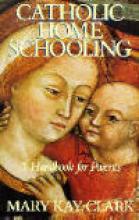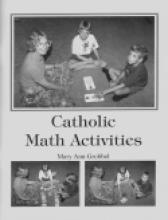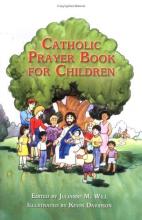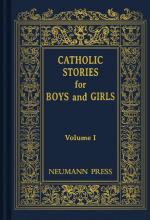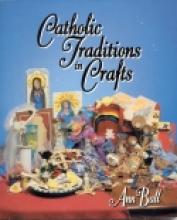No name
Catholic Home Schooling
Note: This review is based on the 1993/1998 editions of this book. The book was rewritten in 2006 and that edition has not yet been reviewed. Mary Kay Clark, who is the director of Seton Home Study has recently revised what was the first book published on Cathholic Homeschooling. It has quite a different flavor from Catholic Education: Homeward Bound and make a strong case for homeschooling from the perspective of Catholic teaching and Church documents. The author includes many practical ideas for running a busy household while homeschooling and finding creative ways of making a structured homeschool program flexible enough for your needs. Chapters include "How to Begin Catholic Home Schooling", "Home Schooling in the Large Family", "The Sacramental Life" and special chapters by other authors on topics such as "The Father's Role in Homeschooling", "Home Management in the Catholic Home Schooling Family" and "Home Schooling the Catholic LD Child." I particularly enjoyed the stories of the author's own homeschooling experiences with her seven boys and her practical ideas of making homeschooling work in the here and now by not expecting to be able to do everything perfectly (e.g. using paper plates and clearing out a lot of unnecessary clutter in the house).
Catholic Homeschooling fills and has filled an important role in the homeschool movement (particularly because it was simply the first book published on Catholic homeschooling) but, like all "advice" on homeschooling (including this website), should be used insofar as it is helpful to your family's needs rather than solely dictate how your family does everything (this, I believe, would be keeping with the author's intentions, particularly as she explains the role of Seton Home Study).
Out-of-date material:
"The only other comprehensive home study program for children which has accreditation is Home Study International, which is run by Seventh-Day Adventists." (p. 103) A number of Catholic homeschool programs as well as Protestant ones are now accredited if that's an important issue to you.
"If you want Catholic textbooks, you need to enroll in a Catholic home study school." (p. 100) This seems rather shockingly out-of-date even for the revision date of 1998. Many Catholic textbooks have been available from numerous sources (including TAN, Neumann Press, Seton Educational Media, Catholic Heritage Curricula, Emmanuel Books, Kolbe Academy, etc.) for a number of years without being enrolled in any school at all.
You'll have to keep in mind that this book is biased toward using a structured homeschool program (and the Seton Home Study program in particular) and doesn't portray the concept of "putting together your own program" particularly well. The computer section is significantly outdated and not particularly useful - for example, it discussescomputer bulletin boards rather than the Internet, and was clearly not revised in the 1998 edition. A few of the parenting ideas that are discussed might be viewed negatively by those of us practicing an "attachment parenting" philosophy. Also I know a number of very good Catholics who were turned off by the authors rather "authoritative" tone and were unwilling to even finish the book. I'm not highly enthusiastic about every resource mentioned in the appendix (although most are great!) but Dr. Clark does recommend one publication that I have serious problems with - Catholic Family News.
Catholic Math Activities
If you're looking for a way to liven up your math program or to bring in some painless math review you have to pick up this book. Catholic Math Activities provides dozens of math games that children actually enjoy playing and almost all of them only require dice and simple home-made material. The author makes use of children's interests by revolving the games around things such as baseball cards and animals. What really pleased me about this program is the clever way our Catholic faith was brought into these games. Some of the games revolve around a short story involving our faith, bible stories (e.g. Noah's Ark and 2 by 2) and simple Catholic sayings to name a few.
I was especially delighted that this book provides games for such a wide range of ages and with a text that is simple enough that an older sibling can read the instructions and then go on to play the game with the younger child. Topping off the program are 40 nicely hand-drawn illustrations of saints. Each saint is accompanied with a short biography and math problems which, when solved, give the child information as to how the picture should be colored. This is definitely a new twist on color by number and one that my children have enjoyed.
Catholic Mosaic – Living the Liturgical Year with Literature
The title clearly explains what this book is all about: Gibson took the twelve months of the year, wove in the liturgical celebrations and linked these to marvelous picture books – creating a mosaic of Catholic culture and beautiful literature.
But this book is much more than an annotated book list, although that is included too. Gibson gives suggested questions for you to discuss with your children. She gives suggested copywork – that is, quotes that children memorize or use for handwriting practice. She gives ideas for activities that will reinforce the meaning of the particular book. She helps families to truly live and embrace the wondrous Catholic traditions connected to feast days, liturgical celebrations and other things Catholic.
Some of the books described and linked in this book are Catholic illustrated classics – books like The Weight of a Mass by Josephine Nobisso, Song of the Swallows by Leo Politi and St. George and the Dragon by Margaret Hodges are extremely popular with many Catholic parents and children. But Gibson goes beyond the “Catholic classics” and mentions books like The Little Match Girl by Hans Christian Andersen (illustrated by Rachel Isadora) and The Giving Tree by Shel Silverstein and how you can apply Catholic teachings to these books, giving your children a rich and lasting understanding of our Catholic culture.
In total, Gibson integrates FIFTY-TWO illustrated children’s books with the Catholic calendar and Catholic living. Books that cover the Mass, First Communion, various saints and important liturgical seasons are included. In addition, she suggests other books which may also work (but omits questions and activities linked to these “second-string” books some of which unfortunately are out-of-print or hard-to-find).
All the primary books are easily attainable from booksellers; in addition, books by popular authors like Tomie dePaola are usually available at public libraries so as not to strain your book budget too much. However, after seeing these books, you might want to have good copies for your home library. Gibson has selected books not only for the meaning in their words, but also for the beauty of their illustrations. These books could easily be used as an art study in conjunction with the literature, religion and other subjects covered in these books.
Further resources that Gibson gives the reader are suggestions for creating and maintaining a “Liturgical Notebook” throughout the year – a memory scrapbook of this literature-based journey – as well as incorporating some of the traditional Catholic homeschool resources (for example, CHC’s A Year with God or Seton’s Art 1).
Run, don’t walk, to get a copy of this book. I know I sound effusive, but this book is remarkable in its ambitious objective which is stunningly successful. This is one of those homeschooling volumes that needs to be on every Catholic resource shelf – that is, when it’s not being used!
Catholic Prayer Book for Children
This is a very nice children's prayer book illustrated with full-color cartoon-like pictures. The book includes:
- Traditional prayers like the Hail Mary, Our Father and Morning Offering
- Prayers of the Saints, like Prayer of Saint Francis and Breastplate of St. Patrick
- Prayers and Mysteries of the Rosary (including the Luminous mysteries)
- Psalms from the Bible
- Some special prayers written just for children
- Gentle invitations for children to talk to God in their own words too.
- A segment on "Going to Confession" which includes instructions as well as prayers
- "Stuff Every Catholic Kid Should Know" like Spiritual and Corporal Works of Mercy and the Ten Commandments
- "Prayers from the Mass"
Also available in softcover
Catholic Prayer Book for Mothers
Catholic Saints Prayer Book
Catholic Stories for Boys and Girls
These charming readers, which are appropriate for a second grade reading level, contain "stories written and compiled in days long past by Catholic nuns in America and dedicated to Mary the Mother of God our dear Lady of the Miraculous Medal." My second grader (who is somewhat advanced in reading level) enjoyed these very much and polished off all four volumes in the first week of school - including one book which she read straight through without putting it down (she requested that I include that detail in the review). She really loves the small size and the beauty of the books themselves and has read them over and over.
I thought it was nice how the stories were so often inter-related as many of them were about the Sisters of Charity and some of their pupils, the founder St. Vincent de Paul, and other related saints, including St. Catherine Laboure and St. Elizabeth Ann Seton. The books introduced my daughter to these saints and others (including St. Isaac Jogues and St. Edmund Campion) and she is now planning on working her way through the Vision Books and Mary Fabyan Windeatt titles about these saints.
The books would offer some good reading practice, a little more appealing than the older Catholic reading texts, while promoting Catholic virtues and tidbits from history. The numerous illustrations are black and white silhouette-like drawings.
Because the books were written for younger children many decades ago, they do display a slight amount of "twaddle" in a few places, along the lines of "'Tick, tock, tick, tock,' said the schoolroom clock as it looked down on the children reading and writing. It liked the French country children." Fortunately, most of the stories are not written in this style. Some parents don't like the way that souls are described as "black" or "white" instead of "in the state of sin" or "in the state of grace" because of the confusing connotations with regard to ethnic background (this also comes up in the Treasure Box Books). Also, although I don't think the authors intended it to come across this way, there is one story in the fourth book which appears to condone one boy beating up another for calling his brother a thief and for cursing. If I remember right, all of these possible objections are limited to the same story in the fourth book ("The Flowery Kingdom" starting on page 45).
4 volumes, 140 pages each
Catholic Talks for Children
Catholic Traditions in Crafts
This book was donated for review by St. Gabriel Gift and Book Nook

